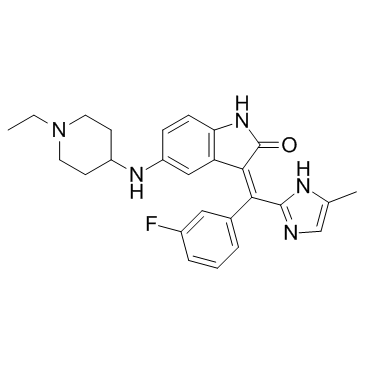Tyrosine kinase-IN-1 |
| Catalog No.GC34026 |
Tyrosine kinase-IN-1 is a multi-targeted tyrosine kinase inhibitor with IC50s of 4, 20, 4, 2 nM for KDR, Flt-1, FGFR1 and PDGFRα, respectively.
Products are for research use only. Not for human use. We do not sell to patients.

Cas No.: 705946-27-6
Sample solution is provided at 25 µL, 10mM.
Tyrosine kinase-IN-1 is a multi-targeted tyrosine kinase inhibitor with IC50s of 4, 20, 4, 2 nM for KDR, Flt-1, FGFR1 and PDGFRα, respectively.
Tyrosine kinase-IN-1 is from reference (compound 8K)[1].
Tyrosine kinase-IN-1 shows a reasonable PK profile (AUC(0-∞)=1.9, t1/2=4.6 h). It has a favorable oral bioavailability (F=63%) in rats[1].
[1]. Moon K, et al. The design, synthesis, and biological evaluation of potent receptor tyrosine kinase inhibitors. Bioorganic & Medicinal Chemistry Letters 22 (2012) 4979-4985
Average Rating: 5 (Based on Reviews and 13 reference(s) in Google Scholar.)
GLPBIO products are for RESEARCH USE ONLY. Please make sure your review or question is research based.
Required fields are marked with *




















